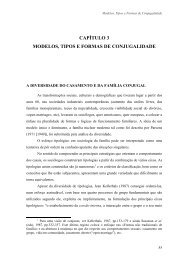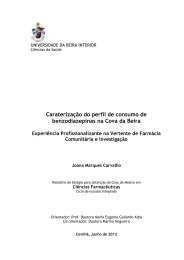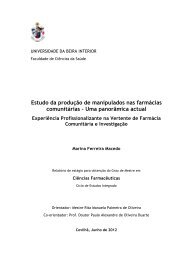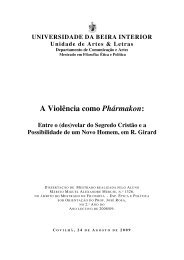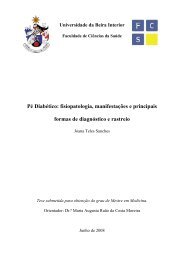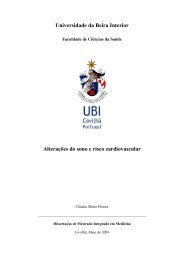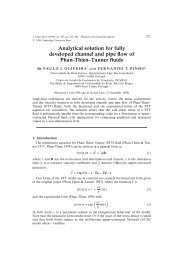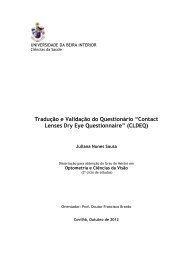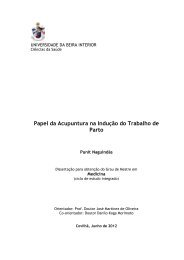Tese_Tânia Vieira.pdf - Ubi Thesis
Tese_Tânia Vieira.pdf - Ubi Thesis
Tese_Tânia Vieira.pdf - Ubi Thesis
Create successful ePaper yourself
Turn your PDF publications into a flip-book with our unique Google optimized e-Paper software.
Chapter I - Introduction<br />
Due to these facts, it is important the use of antibacterial agents to inhibit bacterial<br />
adhesion, in order to prevent implant-associated infections (Kim et al. 2007; Inphonlek et al.<br />
2010; Simchi et al. 2011). In order to achieve this purpose, medical devices with different<br />
antibiotics incorporated such as gentamicin, norfloxacin, nitrofurazone, minocycline, and<br />
rifampin have been produced, to avoid biofilm formation (Dave et al. 2011). However, most of<br />
these coatings only allow short release profiles, making them inappropriate for relatively longterm<br />
use (Dave et al. 2011). Furthermore, some antimicrobial agents are extremely irritant and<br />
toxic to the human being (Sondi et al. 2004), which emphasizes the need to develop<br />
antimicrobial materials to be applied in health and biomedical device, food, and personal<br />
hygiene industries (Häntzschel et al. 2009; Vasilev et al. 2010). These materials must be costeffective,<br />
avoid bacterial resistance for them, have ability to act against a wide spectrum of<br />
bacteria, have high levels of bactericidal and bacteriostatic activity, be safe for the environment<br />
and be biocompatible for eukaryotic cells (Kim et al. 2007; Chaloupka et al. 2010; Fayaz et al.<br />
2010; Inphonlek et al. 2010).<br />
Since the antibiotic resistance is growing up (Nagy et al. 2011) and this has become a<br />
major issue in public healthcare (Mohammed Fayaz et al. 2009), there is a renewed interest in<br />
the development of products containing silver, since these have antimicrobial properties (Arora<br />
et al. 2008; Monteiro et al. 2009; Madhumathi et al. 2010; Nagy et al. 2011). In fact, the<br />
antibiotic-resistant pathogens has led to the resurgence of silver-based materials with<br />
antibacterial agents purpose(da Silva Paula et al. 2009; Fayaz et al. 2010; Kalishwaralal et al.<br />
2010; Huh et al. 2011; Nagy et al. 2011), due to their antimicrobial activity against a large<br />
number of microorganisms and far lower propensity to induce microbial resistance than that of<br />
antibiotics (Arora et al. 2008; Fayaz et al. 2010). Thus, the incorporation of silver in topical<br />
dressings or as coating material on medical products may therefore play an important role in the<br />
era of antibiotic resistance (Ip et al. 2006). However, silver has high toxicity for the human being<br />
and in order to solve this problem, nanoscale materials have emerged as novel effective<br />
alternative to be used as antimicrobial agents (Sondi et al. 2004; Rai et al. 2009).<br />
1.2. Nanotechnology<br />
Nanotechnology is an area of science that appeared in the 20 th century (Lu et al. 2008). It<br />
is emerging as a rapid growing field with applications in Science and Technology at the nanoscale<br />
level (Rai et al. 2009). The term Nanotechnology was created by Professor Norio Taniguchi of<br />
Tokyo Science University in 1974, to describe precision of manufacturing materials at the<br />
nanometer level (Rai et al. 2009). But the concept of Nanotechnology was given previously, in<br />
1959, by physicist Professor Richard P. Feynman in his lecture “There’s plenty of room at the<br />
Bottom” (Rai et al. 2009). The term Nanotechnology is derived from the word “nano” (Rai et al.<br />
2009). “Nano” is a Greek word synonymous to dwarf meaning extremely small, used to indicate<br />
one billionth of a meter or 10 −9 m (Rai et al. 2009). Nanoscale is taken to include active<br />
5




